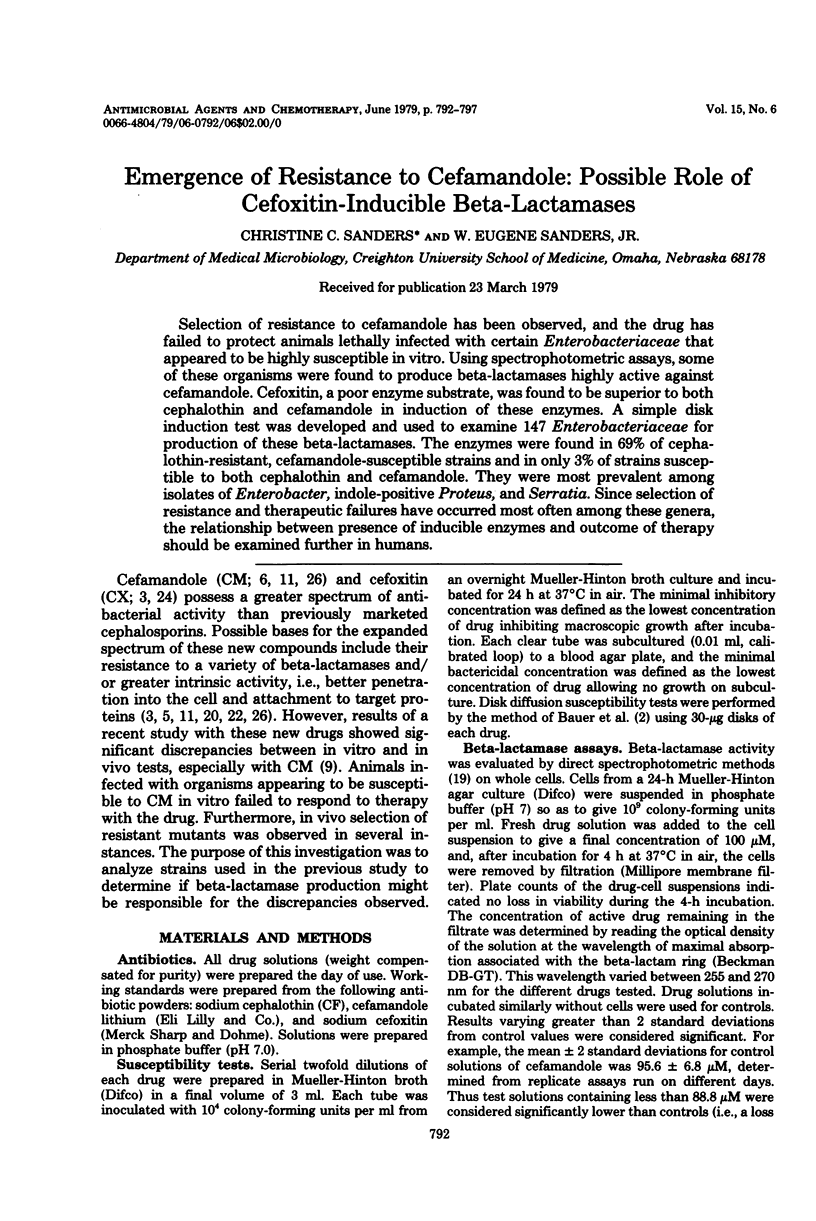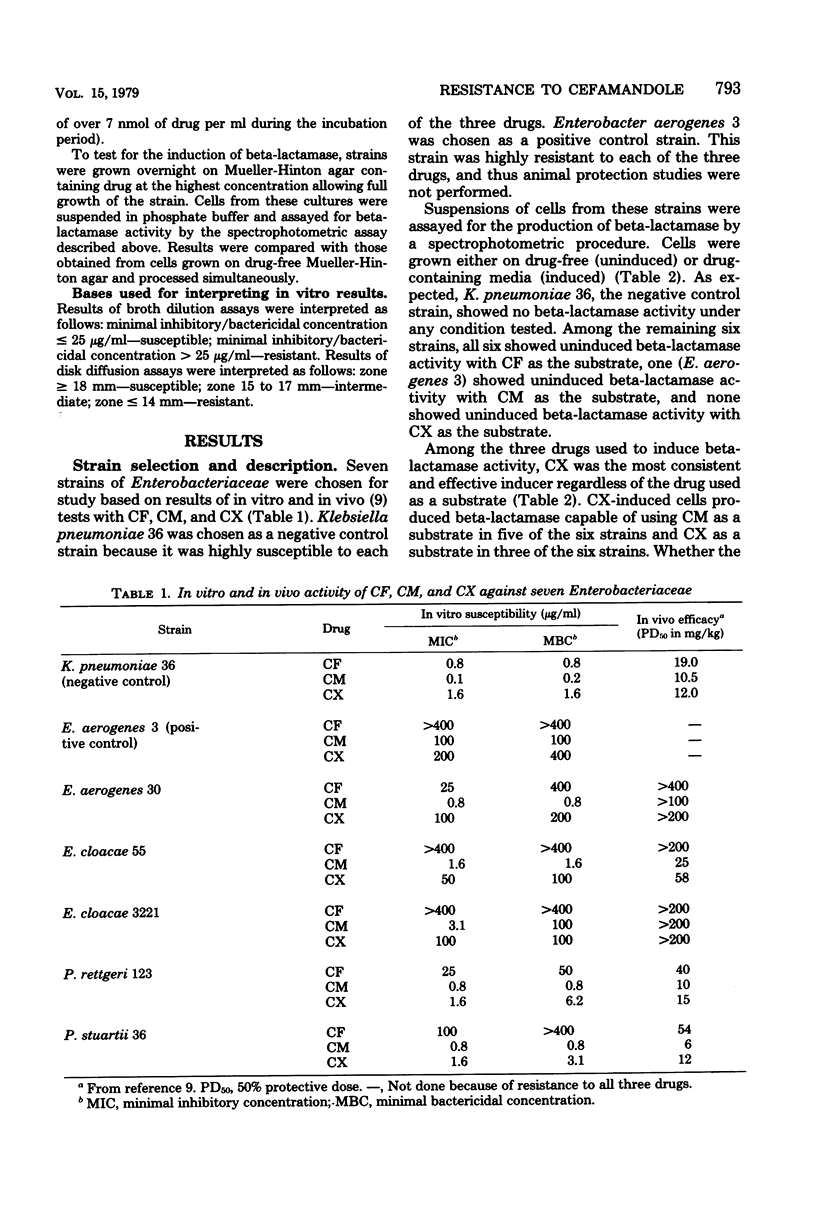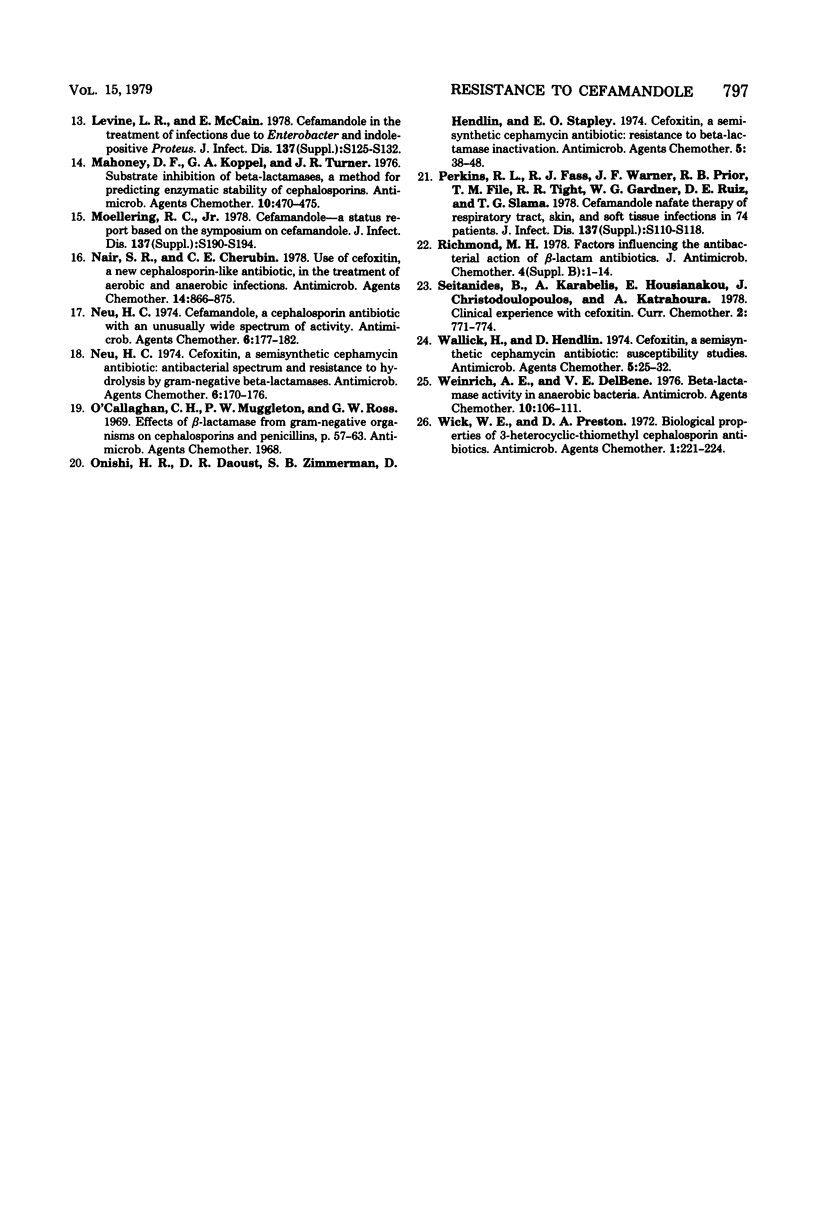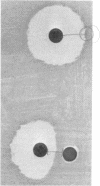Abstract
Selection of resistance to cefamandole has been observed, and the drug has failed to protect animals lethally infected with certain Enterobacteriaceae that appeared to be highly susceptible in vitro. Using spectrophotometric assays, some of these organisms were found to produce beta-lactamases highly active against cefamandole. Cefoxitin, a poor enzyme substrate, was found to be superior to both cephalothin and cefamandole in induction of these enzymes. A simple disk induction test was developed and used to examine 147 Enterobacteriaceae for production of these beta-lactamases. The enzymes were found in 69% of cephalothin-resistant, cefamandole-susceptible strains and in only 3% of strains susceptible to both cephalothin and cefamandole. They were most prevalent among isolates of Enterobacter, indole-positive Proteus, and Serratia. Since selection of resistance and therapeutic failures have occurred most often among these genera, the relationship between presence of inducible enzymes and outcome of therapy should be examined further in humans.
Full text
PDF





Images in this article
Selected References
These references are in PubMed. This may not be the complete list of references from this article.
- Adams H. G., Stilwell G. A., Turck M. In vitro evaluation of cefoxitin and cefamandole. Antimicrob Agents Chemother. 1976 Jun;9(6):1019–1024. doi: 10.1128/aac.9.6.1019. [DOI] [PMC free article] [PubMed] [Google Scholar]
- Bauer A. W., Kirby W. M., Sherris J. C., Turck M. Antibiotic susceptibility testing by a standardized single disk method. Am J Clin Pathol. 1966 Apr;45(4):493–496. [PubMed] [Google Scholar]
- Birnbaum J., Stapley E. O., Miller A. K., Wallick H., Hendlin D., Woodruff H. B. Cefoxitin, a semi-synthetic cephamycin: a microbiological overview. J Antimicrob Chemother. 1978 Jul;4(B):15–32. doi: 10.1093/jac/4.suppl_b.15. [DOI] [PubMed] [Google Scholar]
- Daoust D. R., Onishi H. R., Wallick H., Hendlin D., Stapley E. O. Cephamycins, a new family of beta-lactam antibiotics: antibacterial activity and resistance to beta-lactamase degradation. Antimicrob Agents Chemother. 1973 Feb;3(2):254–261. doi: 10.1128/aac.3.2.254. [DOI] [PMC free article] [PubMed] [Google Scholar]
- Darland G., Birnbaum J. Cefoxitin resistance to beta-lactamase: a major factor for susceptibility of bacteroides fragilis to the antibiotic. Antimicrob Agents Chemother. 1977 Apr;11(4):725–734. doi: 10.1128/aac.11.4.725. [DOI] [PMC free article] [PubMed] [Google Scholar]
- Eykyn S., Jenkins C., King A., Phillips I. Antibacterial activity of cefamandole, a new cephalosporin antibiotic, compared with that of cephaloridine, cephalothin, and cephalexin. Antimicrob Agents Chemother. 1973 Jun;3(6):657–661. doi: 10.1128/aac.3.6.657. [DOI] [PMC free article] [PubMed] [Google Scholar]
- Findell C. M., Sherris J. C. Susceptibility of Enterobacter to cefamandole: evidence for a high mutation rate to resistance. Antimicrob Agents Chemother. 1976 Jun;9(6):970–974. doi: 10.1128/aac.9.6.970. [DOI] [PMC free article] [PubMed] [Google Scholar]
- Fu K. P., Neu H. C. A comparative study of the activity of cefamandole and other cephalosporins and analysis of the beta-lactamase stability and synergy of cefamandole with aminoglycosides. J Infect Dis. 1978 May;137 (Suppl):S38–S50. doi: 10.1093/infdis/137.supplement.s38. [DOI] [PubMed] [Google Scholar]
- Goering R. V., Sanders C. C., Sanders W., Jr Comparison of BL-S786 with cephalothin, cefamandole and cefoxitin in vitro and in treatment of experimental infections in mice. J Antibiot (Tokyo) 1978 Apr;31(4):363–372. doi: 10.7164/antibiotics.31.363. [DOI] [PubMed] [Google Scholar]
- Kaiser G. V., Gorman M., Webber J. A. Cefamandole---a review of chemistry and microbiology. J Infect Dis. 1978 May;137 (Suppl):S10–S16. doi: 10.1093/infdis/137.supplement.s10. [DOI] [PubMed] [Google Scholar]
- Kosmidis J., Hamilton-Miller J. M., Gilchrist J. N., Kerry D. W., Brumfitt W. Cefoxitin, a new semi-synthetic cephamycin: an in-vitro and in-vivo comparison with cephalothin. Br Med J. 1973 Dec 15;4(5893):653–655. doi: 10.1136/bmj.4.5893.653. [DOI] [PMC free article] [PubMed] [Google Scholar]
- Levine L. R., McCain E. Cefamandole in the treatment of infections due to Enterobacter and indole-positive Proteus. J Infect Dis. 1978 May;137 (Suppl):S125–S132. doi: 10.1093/infdis/137.supplement.s125. [DOI] [PubMed] [Google Scholar]
- Mahoney D. F., Koppel G. A., Turner J. R. Substrate inhibition of beta-lactamases, a method for predicting enzymatic stability of cephalosporins. Antimicrob Agents Chemother. 1976 Sep;10(3):470–475. doi: 10.1128/aac.10.3.470. [DOI] [PMC free article] [PubMed] [Google Scholar]
- Moellering R. C., Jr Cefamandole--a status report based on the symposium on cefamandole. J Infect Dis. 1978 May;137 (Suppl):S190–S194. doi: 10.1093/infdis/137.supplement.s190. [DOI] [PubMed] [Google Scholar]
- Nair S. R., Cherubin C. E. Use of cefoxitin, new cephalosporin-like antibiotic, in the treatment of aerobic and anaerobic infections. Antimicrob Agents Chemother. 1978 Dec;14(6):866–875. doi: 10.1128/aac.14.6.866. [DOI] [PMC free article] [PubMed] [Google Scholar]
- Neu H. C. Cefamandole, a cephalosporin antibiotic with an unusually wide spectrum of activity. Antimicrob Agents Chemother. 1974 Aug;6(2):177–182. doi: 10.1128/aac.6.2.177. [DOI] [PMC free article] [PubMed] [Google Scholar]
- Neu H. C. Cefoxitin, a semisynthetic cephamycin antibiotic: antibacterial spectrum and resistance to hydrolysis by gram-negative beta-lactamases. Antimicrob Agents Chemother. 1974 Aug;6(2):170–176. doi: 10.1128/aac.6.2.170. [DOI] [PMC free article] [PubMed] [Google Scholar]
- Onishi H. R., Daoust D. R., Zimmerman S. B., Hendlin D., Stapley E. O. Cefoxitin, a semisynthetic cephamycin antibiotic: resistance to beta-lactamase inactivation. Antimicrob Agents Chemother. 1974 Jan;5(1):38–48. doi: 10.1128/aac.5.1.38. [DOI] [PMC free article] [PubMed] [Google Scholar]
- Perkins R. L., Fass R. J., Warner J. F., Prior R. B., File T. M., Tight R. R., Gardner W. G., Ruiz D. E., Slama T. G. Cefamandole nafate therapy of respiratory tract, skin, and soft tissue infections in 74 patients. J Infect Dis. 1978 May;137 (Suppl):S110–S118. doi: 10.1093/infdis/137.supplement.s110. [DOI] [PubMed] [Google Scholar]
- Richmond M. H. Factors influencing the antibacterial action of beta-lactam antibiotics. J Antimicrob Chemother. 1978 Jul;4(B):1–14. doi: 10.1093/jac/4.suppl_b.1. [DOI] [PubMed] [Google Scholar]
- Wallick H., Hendlin D. Cefoxitin, a semisynthetic cephamycin antibiotic: susceptibility studies. Antimicrob Agents Chemother. 1974 Jan;5(1):25–32. doi: 10.1128/aac.5.1.25. [DOI] [PMC free article] [PubMed] [Google Scholar]
- Weinrich A. E., Del bene V. E. Beta-lactamase activity in anaerobic bacteria. Antimicrob Agents Chemother. 1976 Jul;10(1):106–111. doi: 10.1128/aac.10.1.106. [DOI] [PMC free article] [PubMed] [Google Scholar]
- Wick W. E., Preston D. A. Biological properties of three 3-heterocyclic-thiomethyl cephalosporin antibiotics. Antimicrob Agents Chemother. 1972 Mar;1(3):221–234. doi: 10.1128/aac.1.3.221. [DOI] [PMC free article] [PubMed] [Google Scholar]



